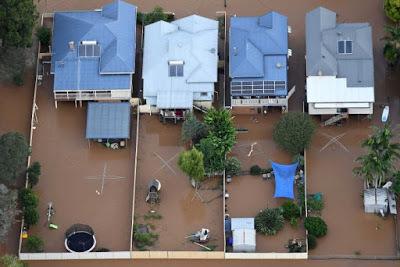GR: We know that global warming increases the chances for severe storms. This article provides explanations and some details on what to expect.

Flooding extremes
“Warm air can be more humid than cold air, that is, it can hold more water vapour in absolute terms. And atmospheric water vapour content increases seven per cent for each 1-degree-Celsius increase in global average temperature, establishing the conditions for more intense rainfall events.
“Flash floods are likely to sweep across the Australian landscape with increasing intensity, particularly in urban or residential areas. Peak rainfall is predicted to soar with rising surface temperatures as Australia experiences ever greater extremes of heat.
“The frequency of major flood events (defined as events which caused extensive flooding within 50 kilometres of the coast, or inundation that extended 20 kilometres along the coast) along Australia’s eastern seaboard has doubled in last 150 years, with climate change one of the possible factors, senior Bureau of Meteorology researchers say.
“Record-breaking heavy rainfall and a clear upward trend in downpours over the last 30 years fits in with global temperature rise caused by greenhouse gases. Statistical analysis of rainfall data from 1901 to 2010 around the globe, shows that from 1980 to 2010 there were 12% more of these intense events than would be expected in a climate without global warming. Wet regions generally saw a bigger increase in deluges and drier regions a smaller one. In southeast Asia, the observed increase in record-breaking rainfall events is as high as 56%.
“Attribution studies show how the risk of a particular event may have changed due to the human influence on climate. Some attribution results surveyed by the World Meteorological Organisation include:
- The US National Oceanic and Atmospheric Administration determined that human-caused climate change increased chances of the fatal and record rains in Louisiana by at least 40% percent and could have nearly doubled the odds of such a storm.
- A scientific analysis of devastating 2014 floods in the United Kingdom, which cost an estimated $646 million in insurance losses, found that human-caused climate change has increased the chance of the extreme rain event by 43%.
- In May-June 2016, portions of northeast France received six full weeks of rain in 24-hours. A formal attribution study released June 9, 2016, found that such extreme rains are at least 40 percent—and as much as 90 percent—more likely in some areas of France.
Cyclone extremes
“Cyclones, in part, draw their energy from the temperature of the ocean’s surface waters, so a warming climate and ocean puts more energy into storms, including cyclones, loading them with more rainfall, and stronger winds pushing more of a storm surge.” –Climate Code Red (Continue: Climate Code Red: Climate change pushing floods, cyclones to new extremes, with worse to come.)

